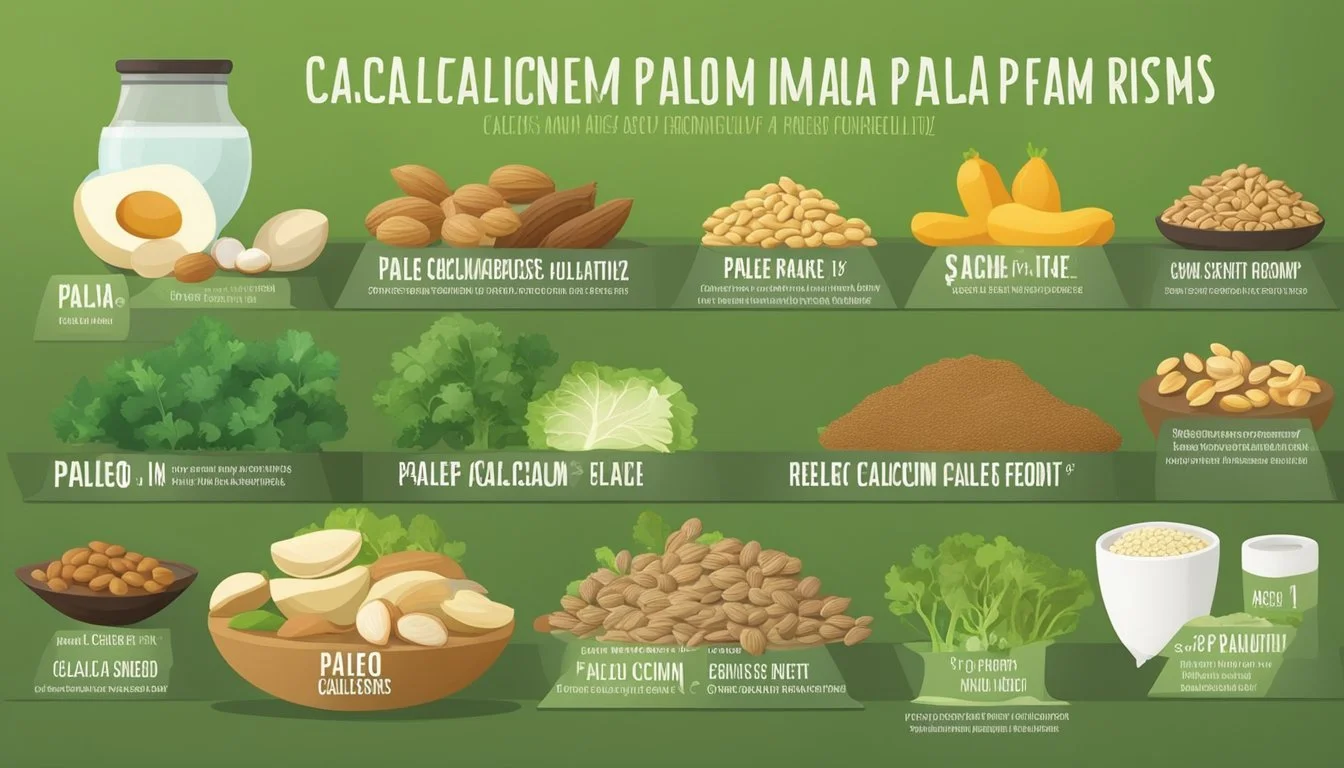Sources of Calcium on the Paleo Diet
Unearthing Nutrient-Rich Foods
Maintaining an adequate intake of calcium is essential for bone and overall health. The paleo diet or Paleolithic diet, which emulates the eating habits of our hunter-gatherer ancestors, prioritizes whole, unprocessed foods. While dairy is traditionally excluded from this dietary pattern, it's still possible to meet the daily calcium requirements through alternative sources. Individuals on a Paleolithic diet can look to leafy green vegetables, nuts (how long do nuts last?), seeds, (how long do seeds last?) and fish as nutrient-dense foods that provide calcium.
The Paleolithic diet supports the consumption of high-quality proteins, fats, and a vast array of plants. This way of eating naturally includes foods with calcium, but it also emphasizes foods that contain other nutrients important for the absorption of calcium and bone health, such as magnesium and vitamin K. The focus on anti-inflammatory foods, like fatty fish and grass-fed meats, alongside a variety of plant foods rich in antioxidants, contributes to the maintenance of calcium balance within the body.
The bioavailability of calcium in certain plant sources may not be as high as that found in dairy, but the Paleolithic diet compensates by encouraging a higher intake of these calcium-containing plants. Additionally, many paleo proponents advocate for responsible sunlight exposure to support vitamin D levels, which play an integral role in the absorption of calcium, further helping to ensure that the body’s calcium needs are met in the absence of dairy.
Understanding Calcium and Its Importance to Bone Health
Calcium is pivotal for the development and maintenance of strong bones and teeth. It is also essential for preventing conditions such as osteoporosis, where decreased bone density is caused by loss of calcium from the bones, characterized by them being weak and brittle. This section will explore the fundamentals of calcium, its relationship with Vit D for absorption, the daily requirements, and the effects of deficiency on bone mineral density and skeletal health.
Calcium Fundamentals
Calcium is the most abundant mineral in the body, with 99% of it concentrated in bones and teeth. It plays an integral role in bones, providing the necessary structure to the skeleton. The remaining 1% of the body's calcium is vital for vascular contraction, muscle function, nerve transmission, blood clotting, and intracellular signaling.
Role of Vitamin D and Absorption Factors
Fat soluble vitamins, like Vitamin D are crucial for the absorption of calcium in the intestines. Without adequate Vit D, the body cannot absorb calcium effectively, regardless of intake levels. Other factors that influence the absorption of calcium include the presence of Vitamin K and magnesium, which work synergistically with Vit D. Additionally, Vitamin K2 plays a role in the proper deposition of calcium into the bone matrix.
Daily Calcium Requirements
The Recommended Dietary Allowance (RDA) for calcium varies across different age groups:
Children 1-3 years: 700 mg/day
Children 4-8 years: 1,000 mg/day
Adults 19-50 years: 1,000 mg/day
Women 51-70 years: 1,200 mg/day
Men 51-70 years: 1,000 mg/day
Adults over 70 years: 1,200 mg/day
Meeting these requirements is essential for maintaining optimal skeletal health and preventing bone density loss.
Effects of Deficiency
So, is it possible to take in adequate calcium on a paleo diet? Calcium deficiency can lead to diminished bone density, increased risk of fractures, and conditions such as osteomalacia in adults and rickets in children. Osteomalacia is characterized by softening of the bones due to improper minerals absorption and mineralization. Prolonged deficiency often results in osteoporosis, a condition where bones become porous and more susceptible to fractures.
Paleo Diet Basics
The Paleolithic diet emphasizes consuming whole, unprocessed foods similar to what might have been eaten during the Paleolithic era. It advocates for a return to the ancestral eating patterns of early humans with a focus on health and well-being.
Core Principles of the Paleo Diet
The Paleolithic diet is founded on the principle of eating foods that are presumed to have been available to humans prior to the advent of modern agriculture. Key characteristics of the diet include:
Whole Foods: Prioritizing unprocessed and unrefined foods.
Protein-Rich: Encouraging consumption of lean meats, fish, and seafood.
Fruits and Vegetables: Emphasizing a variety of fresh produce.
Fats: Including healthful fats from nuts, seeds, and avocados.
Exclusion of Grains and Legumes: Omitting foods that are considered products of agricultural development.
Common Misconceptions About Dairy and Paleo
Dairy is often avoided on the Paleolithic diet, primarily due to:
Lactose Intolerance: Many individuals have difficulty digesting lactose, a sugar found in dairy.
Non-Dairy Focus: As dairy farming is a post-Paleolithic development, the diet excludes milk, cheese, yogurt, and other dairy products.
However, some advocate for the inclusion of dairy if one is not lactose intolerant and chooses products from grass-fed animals due to their nutritional content. It's worth noting that non-dairy calcium sources are also strongly emphasized, such as leafy greens, nuts, seeds, and fish.
Calcium Sources on a Paleo Diet
The Paleolithic diet emphasizes natural, whole foods, similar to what might have been consumed during the Paleolithic era. For those practicing a Paleo diet, intake of calcium is crucial for maintaining skeletal health and can be obtained through a variety of animal and plant-based foods.
Animal-Based Calcium-Rich Foods
On the Paleolithic diet, seafood is an excellent source of calcium, particularly when consuming bone-in fish. Sardines (how long do sardines last?) and salmon, for instance, provide not only calcium but also omega-3 fatty acids which are beneficial for overall health and especially bone metabolism.
Sardines (canned, with bones): A 3.75-ounce can of sardines delivers about 217 mg of calcium.
Salmon (canned, with bones): Half a cup offers around 232 mg of calcium.
Plant-Based Calcium-Rich Foods
Individuals on the Paleolithic diet can obtain calcium from leafy green vegetables and brassica family foods. These options not only contribute to intake of calcium but are also rich in other nutrients.
Leafy greens: Vegetables such as kale, bok choy, and spinach are significant sources of plant-based calcium.
Vegetable Calcium Content per 100g Kale 150 mg Bok choy 105 mg Spinach 99 mg
Nuts and Seeds: Almonds (how long do almonds last?) and chia seeds (how long do chia seeds last?), for example, are nutrient-dense and contain calcium.
Nuts/Seeds Calcium Content per 100g Almonds 264 mg Chia Seeds 631 mg
Consuming a balanced mix of these animal and plant-based foods will help ensure adequate intake of calcium for those on a Paleolithic diet.
Optimizing Calcium Intake
To maintain strong bones and overall health on a Paleolithic diet, it's essential to manage intake of calcium and enhance its absorption. The following subsections will detail how certain factors influence the utilization of calcium and natural ways to boost its absorption.
Factors Affecting Calcium Utilization
Can you get enough calcium on a paleo diet? The absorption and retention of Paleo diet calcium is influenced by a myriad of dietary and lifestyle choices. Protein intake, while necessary for health, can increase the excretion of calcium if consumed in high amounts. Balancing protein with ample magnesium and phosphates is crucial because these minerals work synergistically with calcium.
Fat soluble vitamins, like Vitamin D are pivotal for efficient absorption of calcium. Regular sunlight exposure can elevate vitamin D status, aiding in the calcium absorption process. Conversely, excessive sodium and caffeine consumption might impair calcium retention, and alcohol consumption and smoking are known to negatively affect skeletal health.
Enhancing Calcium Absorption Naturally
For adequate calcium intake on a Paleolithic diet, consider incorporating these strategies:
Maximize vitamin intake: Essential supporting vitamins need to be present in sufficient levels. The include vitamin D, vitamin K, and magnesium, as they are vital co-factors in calcium metabolism. The Paleo diet removes many of the foods with high amounts of phytic acid, resulting in better nutrient availability and absorption.
Focus on gut health: A healthy gut biome aids in the absorption of calcium and other nutrients.
Physical activity: Engage in regular, weight-bearing exercises to stimulate calcium uptake in the bones.
Foods to include for natural calcium intake range:
Leafy green vegetables: kale, spinach, and broccoli.
Nuts and seeds: almonds, sesame seeds (how long do sesame seeds last?), and chia seeds.
Fish: Particularly those with edible bones, like sardines and salmon.
Incorporating these elements into a paleo lifestyle can significantly enhance calcium utilization and support overall skeletal health.
Calcium Supplementation the Paleo Diet
Those who adhere to a Paleolithic diet often avoid dairy products—a common source of calcium. Consequently, they need to ensure adequate intake of calcium through alternative avenues. Supplements can play a vital role in this process but always follow the guidelines of dietary reference intakes.
Calcium Supplements: Fortunately, calcium deficiency is easy to address with a calcium supplement, such as calcium citrate or calcium carbonate. One should consider the elemental calcium content of the supplement to ensure adequate calcium from the daily requirement without dairy.
Vitamin D: Fat soluble vitamins are crucial for the absorption of calcium. If you have a Vitamin D deficiency you can opt for Vitamin D3 supplements, especially during times of low sunlight exposure, to support calcium uptake. Alternatively, Cod Liver Oil is a natural source of Vit D, and Cod Liver Oil contains a high level of Vit D to aid proper absorption of calcium.
Magnesium: This mineral works synergistically with calcium. It is recommended to maintain an appropriate calcium-to-magnesium ratio when supplementing with these nutrients.
Vitamin K2: Vitamin K2 aids in directing calcium to the proper areas in the body, such as bones and teeth, and away from arteries. Therefore, supplements containing Vitamin K2 can be beneficial.
When choosing supplements, individuals should be mindful of the following considerations:
Quality: Opt for high-quality, third-party tested supplements to avoid contaminants.
Balance: Ensure a balance between enough calcium, magnesium, Vitamin D, and K2 to support overall skeletal health.
Dosage: Consult with a healthcare provider to determine how much calcium you need based on individual needs and health.
Individuals need to research and select a calcium supplement that aligns with Paleo principles and addresses their specific dietary restrictions and lifestyle choices.
Health Considerations and Risks
In the context of the Paleolithic diet, considering the balance of enough calcium intake is essential for maintaining bone health and minimizing risks associated with excess intake, such as the potential for kidney stones and cardiovascular issues. So, how much calcium is in different foods? And how do you know if you are getting enough calcium?
Potential Risks of Excessive Calcium Intake
Consuming calcium beyond the body's needs can have several adverse effects. Excessive intake of calcium may lead to hypercalcemia, a condition characterized by elevated levels of calcium in the blood. This can result in calcium deposits in the kidneys, potentially forming kidney stones, which can cause significant pain and kidney damage if not managed properly.
Furthermore, imbalances in calcium consumption are associated with an increased risk of cardiovascular disease. Studies indicate that too much calcium—particularly from supplements rather than food sources—might increase the incidence of heart disease by contributing to the development of plaque in the arteries (atherosclerosis).
In terms of bone health, while it seems counterintuitive, excessive calcium does not translate to stronger bones and, instead, may increase one's risk of osteoporosis. Overconsumption can lead to the body absorbing less of other essential minerals required for bone formation, such as magnesium and phosphorus.
There's also evidence suggesting a link between high intake of calcium and heightened colorectal cancer risk, although more research is needed in this area to understand the dynamics fully.
With the Paleolithic diet excluding dairy—a prime source of dietary calcium—individuals following this diet need to be vigilant in obtaining sufficient calcium for bone health without overconsuming. They must rely on other calcium-rich foods allowed within the Paleo framework, such as leafy greens, certain types of fish, and nuts, to meet their nutritional needs without the risk of excess.
Recipes and Meal Planning
Planning meals on a Paleolithic diet that are rich in calcium requires an understanding of key calcium-rich foods and how to integrate them into daily eating habits. The following subsections will guide one through assembling balanced meals and employing creative ways to use calcium-dense foods within the paleo framework.
Preparing Balanced Paleo Meals with Calcium
One should focus on including a variety of calcium-rich foods in their Paleolithic diet. Vegetables such as broccoli and kale are staples that provide a boost of calcium. Fish, particularly sardines and salmon, are not only high in calcium but also offer essential omega-3 fatty acids. Nuts and seeds, including almonds and sesame seeds, can be additional sources of calcium.
To ensure adequate intake of calcium, a day's meals might look like this:
Breakfast: Scrambled eggs with sautéed kale and seeds.
Lunch: Grilled salmon (What wine goes well with grilled salmon?) salad with mixed greens and a lemon-tahini (how long does tahini last?) dressing.
Dinner: Broccoli and sardine bake with an almond crust.
Creative Uses of Calcium Dense Foods
Incorporating calcium dense foods into paleo recipes can be both straightforward and creative. One might opt for almond flour (how long does almond flour last?) in baking to not only follow paleo guidelines but also to increase the intake of calcium. Creating a pesto with sesame seeds instead of traditional pine nuts adds a twist to the recipe while boosting the calcium level. The suggestion that Bone Broth must be a good source of calcium is misleading. In reality, the calcium varies according to the ingredients and cooking. Calcium levels in bone broth range from 1.5 mg to 55 mg per 240 ml or 1 cup serving size. Nevertheless, bone broth is still a satisfying and enjoyable dish.
Here are some creative recipe ideas:
Almond Flour Pancakes: Substitute regular flour (how long does flour last?) with almond flour for a calcium-enriched breakfast.
Kale Chips: Oven-baked kale chips with a sprinkle of sesame seeds for a crunchy, calcium-rich snack.
Sardine Spread: Blend sardines with herbs and olive oil to make a spread for vegetable crudités.
By focusing on these calcium-rich ingredients, one can confidently meet their dietary needs while enjoying a diverse and delicious array of paleo-friendly meals.
Lifestyle Recommendations for Enhancing Bone Health
To maintain and enhance bone health on a Paleolithic diet, it is crucial to consider lifestyle factors beyond dietary calcium. Regular physical activity and adequate sun exposure play significant roles in supporting bone density and overall bone health.
Physical Activity's Role in Strengthening Bones
Regular physical activity is essential for maintaining strong healthy bones. Weight-bearing exercises, such as walking, running, and resistance training, stimulate bone formation and preserve bone density. Adults are advised to engage in at least 150 minutes of moderate-intensity or 75 minutes of high-intensity exercise each week. Activities should include:
Strength training: Lifting weights or bodyweight exercises (at least 2 days a week)
Balance exercises: Yoga or Tai Chi to improve coordination and prevent falls
Weight-bearing cardio: Walking, jogging, or playing tennis
Sunlight and Bone Health
Sunlight exposure is a critical non-dietary factor for bone health, primarily due to its role in vitamin D synthesis. Vitamin D facilitates calcium absorption, which is vital for bone health. Recommended sunlight exposure should be:
Duration: 10-30 minutes of midday sunlight several times per week
Skin exposure: Face, arms, legs, or back without sunscreen
It is important to be mindful of individual skin sensitivities and local UV index guidelines to prevent skin damage.





